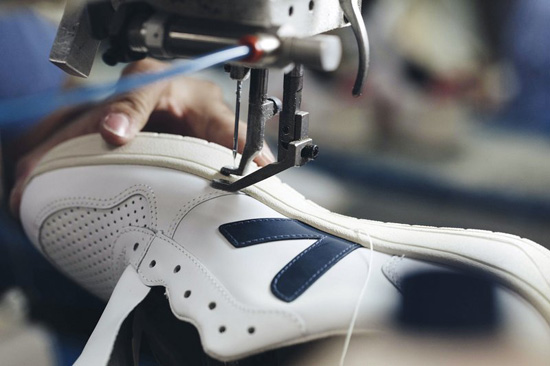要时尚,不要污染

巴西南部的一家工厂正在生产Veja运动鞋;所有的Veja工厂都遵守国际劳工组织的规定。图片来源:Courtesy of Charlotte Lapalus
|
时尚的隽永魅力在于它可以是消费者想要的任何东西——它是表达自我的方式,是对原创和精湛工艺的颂扬,也可以是一种暂时的快乐。但如今一个无法回避的事实是,时尚也让我们有负担,因为它是全球污染最严重、浪费最严重的行业之一。 艾伦麦克阿瑟基金会(Ellen MacArthur Foundation)近期的报告显示,全球纺织品生产量过去15年增长了一倍以上,而消费者每件衣服的平均持有时间仅仅是15年的一半。美国超过85%的废弃服装最终都被送进了垃圾填埋场,这种生产/使用/丢弃的循环代价相当高——根据《联合国气候变化框架公约》(UN Framework Convention on Climate Change),时尚业的温室气体排放量超过了国际海运和航空业的排放量总和。而且这还不算困扰全球多数快消时尚和奢侈品品牌的不道德劳动行为。 业内大规模不负责任的行为成为激发Veja灵感的部分原因,这家巴黎制鞋业的宠儿甚至早在“可持续”成为时髦口号前就已经是可持续时尚界的先锋了。2005年,当其它品牌还在互联网上酝酿时,弗朗索瓦-吉兰·莫里隆和萨巴斯蒂安·寇波看到了一个带有他们这代人实体印记的机遇:运动鞋。不像其它同品类大品牌那样把七成的成本花在广告上,原材料和生产只花三成,他们把所有资源都花在了生产可持续产品上(成本是其他运动鞋的五到七倍)以及制作工人身上。他们把工厂设在巴西,那里有公平贸易认证的棉花,有来自亚马逊地区的野生橡胶,有合理支付工人工资的工厂。今天,他们还使用升级再造的罗非鱼皮、回收的塑料瓶以及法兰绒、丝绸和其他环保材料做鞋——外观漂亮,制作精良。 |
The enduring appeal of fashion is that it can be whatever consumers want it to be—a means of self-expression, a celebration of originality and fine craftsmanship, or a temporary pleasure. But today, there’s no escaping that it comes with the burden of knowing it’s among the world’s most polluting and wasteful industries. According to recent reports by the Ellen MacArthur Foundation, global textile production has more than doubled in the past 15 years, while the average shopper holds on to clothing for half that long. Over 85% of discarded clothing in the U.S. ends up in landfills, and this cycle of make/use/waste comes at a considerable cost—the industry generates more greenhouse gas emissions than do international maritime shipping and aviation combined, says the UN Framework Convention on Climate Change. And that’s saying nothing of the unethical labor practices that have plagued many of the world’s fast-fashion and luxury brands. It’s partly this colossal irresponsibility that sparked the idea for Veja, the footwear industry’s Parisian darling that has been at the vanguard of the sustainable fashion sphere long before “sustainable” was even a buzz- word. In 2005, while other brands were being born online, François-Ghislain Morillion and Sébastien Kopp saw opportunity with a physical emblem of their generation: the sneaker. Unlike the big names in the category that spend 70% on advertising and 30% on raw materials and production, they devoted all their resources to a sustainably manufactured product (that costs five to seven times as much to make as other sneakers cost) and the people who make it. This happens in Brazil, where they have access to fair-trade cotton and wild rubber from Amazonia, and factories that pay their workers fair wages. Today, they also use upcycled tilapia hides; recycled plastic bottles; and flannel, silk, and other eco-friendly materials for their shoes—that are as good-looking as they are well made. |

Veja和巴西(如图)及秘鲁的有机棉花生产商直接合作。图片来源:Courtesy of Charlotte Lapalus
|
13年过去了,Veja每年在全球销售近200万双鞋,其创始人在继续传递这个信息:可持续的生意是根本意义上的好生意。 这种模式适合Veja,因为它一开始的定位就是一个可持续发展品牌。拥有嵌入式供应链和制造设施的传统品牌却需要面临更大挑战。 业内很少有公司像开云集团(Kering)这样直面这项任务,可持续发展已经成为了开云的一项道德准则。2017年,就在开云被《企业爵士》(Corporate Knights)的全球可持续发展企业百强榜单(Global 100 Index)评为顶尖可持续纺织品、服装和奢侈品公司前,该集团公开宣布了2025年之前的可持续发展量化目标。其中最主要的目标是整体环境足迹减少40%。其它行动计划涉及供应、制造、分销和研发的每一个环节,也都在网上一一列明,这说明信息透明不再是破坏奢侈品排他性光环的敌人。 “我们在分享我们学到的知识,在开放我们创新做法的源代码。”开云的首席可持续发展官玛丽-克莱尔·戴维表示。 尽管曲高和寡的高端珠宝业曾经是最不可能改变的行业,集中了全球知名腕表和珠宝品牌的巴黎圣地旺多姆广场(Place Vendôme)仍然见证了颠覆性变化的出现。库尔贝(Courbet)于今年5月登场,它是广场上首个销售100%道德、可持续产品的品牌,使用可回收、可追溯的黄金和实验室生产的最高颜色等级的钻石。这些钻石比天然开采的钻石便宜30%,天然钻石产生的污染是实验室钻石的15000倍,后者是用太阳能机器制造的。世界各地的百货商店已经开始电话下订,当地人更是立刻表现出了兴趣。品牌的联合创始人曼努尔·迈伦表示,道德是很重要的一部分,但美感同样重要——这就是为什么这么多只关注生态的品牌没能赢得消费者的原因。“要想取得长久的胜利,产品必须要美。”他说。(财富中文网) 本文另一版本刊载于2019年1月的《财富》杂志,文章题目是《美与可持续》。 译者:Agatha |
Thirteen years later, with nearly 2 million pairs sold around the world, the founders continue to push the message that sustainable business is ultimately good business. This works for Veja because it was built as a sustainable brand at its onset. But legacy brands, with embedded supply chains and manufacturing facilities, face a bigger challenge. Few in the industry are rising to the task quite like Kering, for whom sustainability has become a moral lodestar. In 2017, just before being named the top sustainable textile, apparel, and luxury goods corporation by the Corporate Knights Global 100 Index, the conglomerate publicly announced its quantitative objectives in sustainability through 2025. Chief among them: reducing its environmental footprint overall by 40%. The rest of its actions, which touch every step of the supply chain, as well as manufacturing, distribution, and R&D, are explicitly outlined online, suggesting transparency is no longer an enemy to luxury’s aura of exclusivity. “We are sharing the knowledge we gain and open-sourcing the innovations we develop,” explains Marie-Claire Daveu, Kering’s chief sustainability officer. And as unlikely as change may once have been in the rarefied world of high-end jewelry, disruption has also found its way to Place Vendôme, the Parisian mecca of the world’s most prestigious watch and jewelry brands. Courbet launched in May as the scene’s first 100% ethical and sustainable line, using recycled, traceable gold and lab-grown diamonds of the highest color grade. These are 30% less expensive than mined diamonds—the latter producing 15,000 times the pollution of lab-grown ones, which are made with solar- powered machines. Department stores world-wide have already started calling to place orders, and local interest was instantaneous. Ethics are a big part of it, says cofounder Manuel Mallen, but aesthetics matter equally—which is why so many eco-only brands have failed to win over consumers. “For good to triumph, the product has to be beautiful,” he says. A version of this article appears in the January 2019 issue of Fortune with the headline “Beautiful and Sustainable.” |













